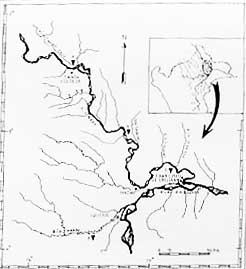

This study was carried out in four areas: the mouth of the Tambor river (73º39'W, 02º28'S), Puerto Huamán village (73º11'W, 12º59'S), the Juancho Playa village (72º50'W, 03º18'S) in the Napo river basin (Fig. 1a, b, c), and in the Mishana village (73'28'W, 03'52'S) in the Nanay river basin (Fig. Id). Observations were conducted from January to March and from November to December 1986 in the Napo river basin, and from April to July 1987, 1990, and 1991 in the Nanay river. AQUINO and ENCARNACIÓN (1986) and PUERTAS et al. (1992) present detailed descriptions about topography and forest type for both basins.
 |
Fig. 1. Study areas. a) Mouth of Tambor river; b) Puerto Huamán village; c) Juancho Playa village; d) Mishana village. |
Data on cohabitation and cooccupation between Aotus and other nocturnal mammals were obtained from 150 hours of observations during twilight (18:00 to 19:00) and dawn (04:30 to 06:00). Both interactions (cohabitation and cooccupation) were distinguished by examining holes in the tree trunks. We located the sleeping sites of Aotus by following groups of Aotus during the night. During the diurnal resting times of Aotus, we also noted other nocturnal animals that slept in the same sites as Aotus.
The majority of the sleeping sites observed was in trees along the shores of rivers, creeks, and channels, and the margins of ox-bow lakes. We occasionally observed sleeping sites in trees located within the forest away from forest edges. Botanical samples of these sleeping trees were collected for identification. The height of sleeping sites was determined with the aid of a field assistant who was trained in climbing trees.
